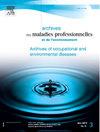在职业后和接触后随访中考虑患者的焦虑:在区域职业和环境病理中心进行的观察性研究
IF 0.3
4区 医学
Q4 PUBLIC, ENVIRONMENTAL & OCCUPATIONAL HEALTH
Archives Des Maladies Professionnelles Et De L Environnement
Pub Date : 2025-02-01
DOI:10.1016/j.admp.2024.102793
引用次数: 0
摘要
自30年前成立以来,职业后随访(PSPs)和接触后随访(PSPs)仍然没有得到潜在受益人的充分利用,最近的改革并没有改善这种情况。作为一种二级预防设施,它们的目的是在接触过致癌物的退休人员中尽早发现可能的疾病。不求助的原因之一是受助人对医疗检查感到焦虑。其目的是强调职业医生如何在会诊中考虑病人的焦虑表现,以实现其预防目标。材料和方法收集的数据来自Finistere癌症术后随访干预研究(Rispop29),该研究由国家癌症研究所(印加)资助,自2020年以来一直在进行。这一分析是基于对布雷斯特CHRU区域职业和环境病理学中心(CRPPE)进行的医疗咨询的观察。结果PES和EPS会诊是应患者要求进行的,与职业指导无关,并与已不再有效的职业接触有关。患者对检测结果的期望很高。焦虑影响着会诊的进行。两个案例研究说明了在这种情况下表达的否认和痛苦。在第一种情况下,医生试图暴露病人的焦虑,以保护自己,而在第二种情况下,医生试图通过提供心理支持来减少这种焦虑。讨论我们面临的挑战是,通过在强调疾病风险和需要保证之间找到平衡,以确保患者充分意识到风险,但这不会使他们瘫痪,从而保持患者的依从性。结论医生有资源来调节病人的焦虑。为受益人提供心理支持肯定会增加追索权的比例。介绍自30年前成立以来,职业后(POM)和接触后(PEM)监测一直没有得到潜在受益人的充分利用,最近的改革并没有改善这种情况。作为二级预防方案,它们的目的是在接触过致癌物的退休人员中尽早发现疾病的开始。不使用的原因之一是受益人在面对医疗检查时感到焦虑。目的是展示职业医生在会诊期间如何考虑病人的焦虑经历,从而实现他们的预防目标。使用的数据来自Finistere (Rispop29)的职业后癌症监测干预研究,该研究由法国国家癌症研究所(Inca)资助,自2020年以来一直在运行。这一分析是基于对位于布雷斯特的CHRU职业和环境病理学区域中心进行的医疗咨询的观察。结果POM和PEM会诊占据了患者的要求,不考虑职业指导,并关注不再相关的职业暴露。患者对检查结果抱有很高的期望。焦虑在咨询过程中是一个沉重的负担。两个案例研究说明了在这种情况下所表达的否认和不安。在第一种情况下,医生试图揭示病人正在保护自己免受的焦虑,而在第二种情况下,他试图通过提供心理支持来减少这种焦虑。讨论我们面临的挑战是通过在强调病理风险和需要再保险之间找到平衡来保持患者的承诺,使患者充分意识到风险,但不会因此而瘫痪。结论医生有资源可以支配,他可以移动来调节病人的焦虑。为受益人提供心理支助肯定会增加收款率。本文章由计算机程序翻译,如有差异,请以英文原文为准。
Prise en compte de l’anxiété du patient dans les consultations de suivi post-professionnel et post-exposition : étude observationnelle dans un centre régional de pathologies professionnelles et environnementales
Introduction
Depuis sa création il y a 30 ans, les suivis post-professionnel (SPP) et post-exposition (SPE) restent sous-utilisés par les bénéficiaires potentiels et leur récente réforme n’a pas amélioré la situation. Dispositif de prévention secondaire, ils visent à détecter au plus tôt l’apparition d’une éventuelle maladie chez des retraités qui ont été exposés à des cancérogènes. L’une des raisons qui expliquent le non-recours est l’anxiété ressentie par les bénéficiaires face aux examens médicaux. On cherche à mettre en évidence comment les médecins du travail prennent en compte l’anxiété qui se manifeste chez leurs patients lors des consultations de manière à atteindre leurs objectifs de prévention.
Matériels et méthodes
Les données mobilisées proviennent de la Recherche interventionnelle sur le suivi post-professionnel des cancers en Finistère (Rispop29) financée par l’Institut national du cancer (Inca) menée depuis 2020. L’analyse repose sur l’observation de consultations médicales réalisées au centre régional de pathologies professionnelles et environnementales (CRPPE) du CHRU de Brest.
Résultats
Les consultations de SPP et SPE adviennent à la demande du patient, n’ont aucun enjeu en termes d’orientation professionnelle et portent sur une exposition professionnelle qui n’est plus d’actualité. L’attente du résultat des examens est très forte chez les patients. L’anxiété pèse sur le déroulement de la consultation. Deux études de cas illustrent le déni et la détresse qui s’expriment dans ce contexte. Le médecin cherche dans le premier cas à faire apparaître l’anxiété dont le patient se protège alors que, dans le second cas, il cherche à réduire cette anxiété en proposant une prise en charge psychologique.
Discussion
L’enjeu est d’arriver à maintenir l’adhésion du patient en trouvant un équilibre entre la mise en évidence d’un risque de pathologie et la nécessité de rassurer, afin que le patient soit suffisamment conscient du risque, mais que celui-ci ne le paralyse pas.
Conclusion
Le médecin dispose de ressources qu’il mobilise pour réguler l’anxiété du patient. La mise en place d’un accompagnement psychologique des bénéficiaires augmenterait certainement le taux de recours.
Introduction
Since their creation 30 years ago, post-occupational (POM) and post-exposition (PEM) monitoring has remained under-utilized by potential beneficiaries, and their recent reform has not improved the situation. As secondary prevention programs, they aim to detect the onset of disease as early as possible in retirees who have been exposed to carcinogens. One of the reasons for non-use is the anxiety felt by beneficiaries when faced with medical examinations. The aim is to show how occupational physicians take into account the anxiety their patients experience during consultations, so as to achieve their prevention objectives.
Materials and methods
The data used come from the interventional research on post-occupational cancer monitoring in Finistère (Rispop29), financed by the French National Cancer Institute (Inca) and running since 2020. The analysis is based on the observation of medical consultations carried out at the Regional Center for Occupational and Environmental Pathologies of the CHRU in Brest.
Results
POM and PEM consultations occur at the patient's request, have no bearing on career orientation, and concern occupational exposure that is no longer relevant. Patients have very high expectations of the results of their examinations. Anxiety weighs heavily on the consultation process. Two case studies illustrate the denial and distress expressed in this context. In the first case, the physician seeks to reveal the anxiety that the patient is protecting himself from, while in the second, he seeks to reduce this anxiety by offering psychological support.
Discussion
The challenge is to maintain the patient's commitment by finding a balance between highlighting the risk of pathology and the need for reassurance, so that the patient is sufficiently aware of the risk but is not paralyzed by it.
Conclusion
The physician has resources at his disposal that he can mobilize to regulate the patient's anxiety. The introduction of psychological support for beneficiaries would certainly increase the take-up rate.
求助全文
通过发布文献求助,成功后即可免费获取论文全文。
去求助
来源期刊

Archives Des Maladies Professionnelles Et De L Environnement
医学-公共卫生、环境卫生与职业卫生
CiteScore
0.40
自引率
50.00%
发文量
185
审稿时长
50 days
期刊介绍:
The Archives of Occupational and Environmental Diseases (Archives des maladies professionnelles et de l''environnement) publish scientific original articles in the form of memoirs, developments and general health reviews. The journal is a reliable source of information, which lets you gain additional knowledge or update your knowledge of basic or original issues.
The section Continuous professional development focuses on a major issue and gives you the tools to optimize your practice. The content is divided in 3 parts: Reading Test, Answer to the Reading Test and Scientific Press Review, which let you share the analysis, by the editorial board, of articles from major English-language journals.
The section Legal Environment discusses an environmental culture. The section Letter to the editor keeps you informed about the press review; the Legislation, with the latest regulations published in the Official Journal; and the agenda of the meetings and the Congress, the questions–answers, etc. The Archives of Occupational and Environmental Diseases include all the scientific communications of the French occupational health societies, of which they are the official journal.
 求助内容:
求助内容: 应助结果提醒方式:
应助结果提醒方式:


